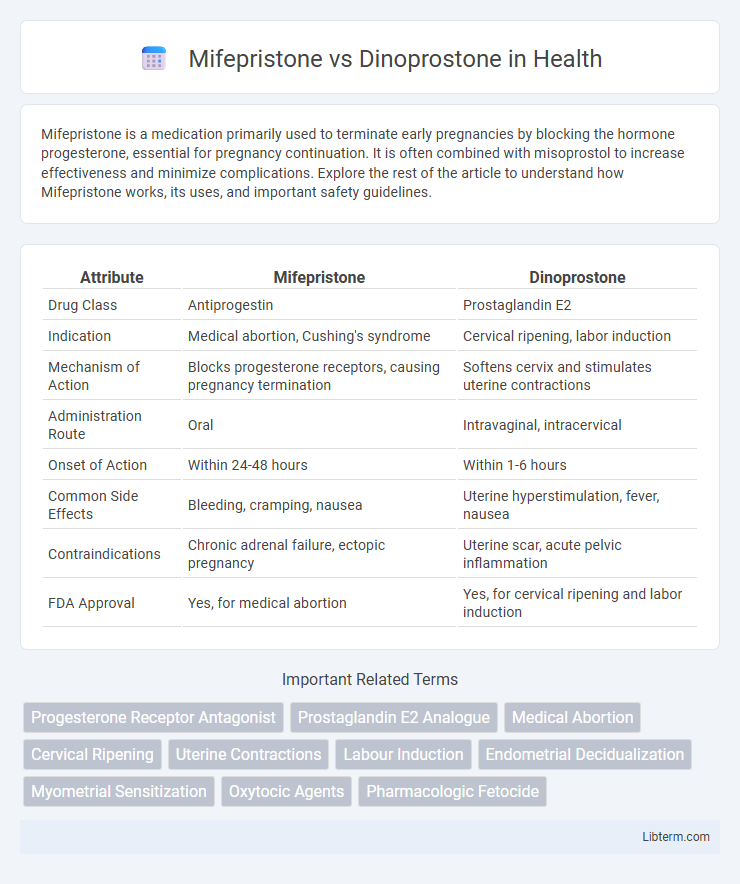Mifepristone is a medication primarily used to terminate early pregnancies by blocking the hormone progesterone, essential for pregnancy continuation. It is often combined with misoprostol to increase effectiveness and minimize complications. Explore the rest of the article to understand how Mifepristone works, its uses, and important safety guidelines.
Table of Comparison
| Attribute | Mifepristone | Dinoprostone |
|---|---|---|
| Drug Class | Antiprogestin | Prostaglandin E2 |
| Indication | Medical abortion, Cushing's syndrome | Cervical ripening, labor induction |
| Mechanism of Action | Blocks progesterone receptors, causing pregnancy termination | Softens cervix and stimulates uterine contractions |
| Administration Route | Oral | Intravaginal, intracervical |
| Onset of Action | Within 24-48 hours | Within 1-6 hours |
| Common Side Effects | Bleeding, cramping, nausea | Uterine hyperstimulation, fever, nausea |
| Contraindications | Chronic adrenal failure, ectopic pregnancy | Uterine scar, acute pelvic inflammation |
| FDA Approval | Yes, for medical abortion | Yes, for cervical ripening and labor induction |
Introduction to Mifepristone and Dinoprostone
Mifepristone is a synthetic steroid used primarily for medical termination of early pregnancy by blocking progesterone receptors, which are essential for pregnancy maintenance. Dinoprostone, a naturally occurring prostaglandin E2, is commonly used for cervical ripening and induction of labor by promoting uterine contractions and softening the cervix. Both agents play distinct roles in obstetrics and gynecology, with mifepristone acting as an abortifacient and dinoprostone facilitating labor processes.
Chemical Composition and Mechanisms of Action
Mifepristone is a synthetic steroid with a complex chemical structure characterized by a 19-norsteroid framework that functions as a progesterone receptor antagonist, effectively blocking the hormone's action to inhibit pregnancy progression. Dinoprostone, chemically designated as prostaglandin E2, is a naturally occurring prostaglandin with a 20-carbon fatty acid structure that induces cervical ripening and uterine contractions by binding to prostaglandin E receptors. The distinct mechanisms--mifepristone's blockade of progesterone receptors versus dinoprostone's stimulation of prostaglandin receptors--highlight their complementary roles in medical termination of pregnancy and labor induction.
Indications and Medical Uses
Mifepristone is primarily indicated for medical termination of intrauterine pregnancy up to 70 days gestation and is also used to manage Cushing's syndrome by inhibiting progesterone and glucocorticoid receptors. Dinoprostone, a synthetic prostaglandin E2 analog, is mainly used to induce labor by ripening the cervix and initiating uterine contractions, as well as to facilitate the evacuation of the uterus in cases of missed miscarriage or abortion. While both drugs facilitate pregnancy termination, mifepristone acts by blocking progesterone, essential for pregnancy maintenance, whereas dinoprostone promotes cervical dilation and uterine contractions to expel uterine contents.
Efficacy Comparison in Clinical Practice
Mifepristone demonstrates higher efficacy for medical termination of early pregnancy by effectively blocking progesterone receptors, leading to rapid decidual breakdown, while dinoprostone, a prostaglandin E2 analog, primarily induces cervical ripening and uterine contractions. Clinical studies reveal that mifepristone combined with misoprostol achieves success rates exceeding 95% within the first trimester, whereas dinoprostone's efficacy as a labor inducer or abortion agent ranges from 70% to 85%, often requiring supplemental agents. The superior pharmacodynamic profile of mifepristone contributes to shorter induction-to-expulsion intervals and reduced need for surgical intervention compared to dinoprostone in clinical practice.
Safety Profiles and Side Effects
Mifepristone, used primarily for medical abortion, presents common side effects such as cramping, bleeding, nausea, and rare severe infections, with a generally strong safety profile when administered under medical supervision. Dinoprostone, a prostaglandin analog used for cervical ripening and labor induction, can cause uterine hyperstimulation, fever, and gastrointestinal discomfort, requiring careful monitoring to prevent adverse outcomes. Both drugs necessitate medical guidance to manage side effects effectively and minimize risks, particularly in vulnerable populations.
Methods of Administration
Mifepristone is commonly administered orally in tablet form, typically taken 24 to 48 hours before a prostaglandin to induce medical abortion. Dinoprostone is usually delivered vaginally as a gel, insert, or pessary to stimulate cervical ripening and labor induction. Both methods require precise timing and dosage to ensure efficacy and minimize side effects.
Contraindications and Precautions
Mifepristone is contraindicated in patients with chronic adrenal failure, long-term corticosteroid therapy, or known ectopic pregnancy, while dinoprostone is contraindicated in cases of previous cesarean delivery, unexplained vaginal bleeding, or acute pelvic inflammatory disease. Precautions for mifepristone include monitoring for heavy bleeding and infection risk, whereas dinoprostone requires careful administration in women with asthma, glaucoma, or cardiovascular disease due to potential adverse effects. Both drugs necessitate thorough patient evaluation to avoid serious complications during medical termination of pregnancy or labor induction.
Patient Outcomes and Satisfaction
Mifepristone demonstrates higher efficacy in cervical ripening and induction of labor compared to Dinoprostone, often resulting in shorter labor duration and reduced need for additional interventions. Patients treated with Mifepristone report greater overall satisfaction due to fewer side effects such as uterine hyperstimulation and lower rates of infection. Clinical studies indicate improved maternal and neonatal outcomes with Mifepristone, reinforcing its preference for labor induction protocols focused on safety and patient experience.
Cost and Accessibility
Mifepristone typically has a higher cost compared to dinoprostone, affecting its accessibility in low-income regions where budget constraints limit pharmaceutical options. Dinoprostone's wider availability and lower price make it a more accessible choice for labor induction and abortion services in many healthcare settings worldwide. Cost-effectiveness and distribution channels heavily influence the selection between mifepristone and dinoprostone in both public and private health systems.
Summary and Clinical Recommendations
Mifepristone and Dinoprostone are both used for medical termination of pregnancy but differ in mechanism and clinical applications. Mifepristone, a progesterone receptor antagonist, is typically administered with misoprostol for effective early pregnancy termination up to 10 weeks, showing higher efficacy and safety profiles. Dinoprostone, a prostaglandin E2 analog, is primarily utilized for cervical ripening and labor induction, with use in medical abortions being less common and generally reserved for specific clinical scenarios.
Mifepristone Infographic

 libterm.com
libterm.com